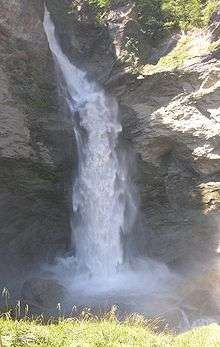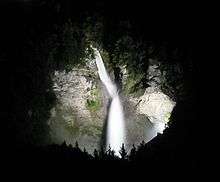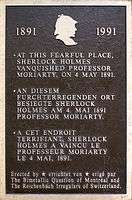Reichenbach Falls


The Reichenbach Falls (German: Reichenbachfall) are a series of waterfalls on the Reichenbach stream in the Bernese Oberland region of Switzerland. They have a total drop of 250 metres (820 ft). At 90 metres (300 ft), the Upper Reichenbach Falls is one of the highest waterfalls in the Alps. Today, a hydro-electric power company harnesses the flow of the Reichenbach Falls during certain times of year, reducing its flow.[1][2][3]
In popular literature, Sir Arthur Conan Doyle gave the falls as the location of the final physical altercation between his hero Sherlock Holmes with his greatest foe, the criminal Professor Moriarty in "The Final Problem".
Location
The falls are located in the lower part of the Reichenbachtal valley, on the Reichenbach stream, a tributary of the Aare. They are some 2 km (1.2 mi) south of the town of Meiringen, and 25 km (16 mi) east of Interlaken. Politically, the falls are within the municipality of Schattenhalb in the canton of Bern.[1][4]
The falls are made accessible by the Reichenbachfall funicular. The lower station is some 20 minutes walk, or a 6-minute bus ride, from Meiringen station on the Brünig railway line that links Interlaken and Lucerne.[1][4]
In popular culture
Arthur Conan Doyle's Sherlock Holmes stories
The town and the falls are known worldwide as the setting for a fictional event: it is the location where Sir Arthur Conan Doyle's hero, Sherlock Holmes, fights to the death with Professor Moriarty, at the end of "The Final Problem", first published in 1893. A memorial plate at the funicular station commemorates Holmes and there is also a Sherlock Holmes museum in the nearby town of Meiringen.[5]
Out of many waterfalls in the Bernese Oberland, the Reichenbach Falls seems to have made the greatest impression on Sir Arthur Conan Doyle, who was shown them on a Swiss holiday by his host Sir Henry Lunn, the founder of Lunn Poly. Sir Henry's grandson, Peter Lunn, recalled, "My grandfather said 'Push him over the Reichenbach Falls' and Conan Doyle hadn’t heard of them, so he showed them to him." So impressed was Doyle that he decided to let his hero die there.[5]
The actual ledge from which Moriarty fell is on the other side of the falls from the funicular; it is accessible by climbing the path to the top of the falls, crossing the bridge and following the trail down the hill. The ledge is marked by a plaque as illustrated here; the English inscription reads: "At this fearful place, Sherlock Holmes vanquished Professor Moriarty, on 4 May 1891." The pathway on which the duel between Sherlock Holmes and Professor Moriarty occurs ends some hundred metres away from the falls. When Doyle viewed the falls, the path ended very close to the falls, close enough to touch it, yet over the hundred years after his visit, the pathway has become unsafe and slowly eroded away, and the falls have receded farther back into the gorge.[5]
In other media
The Reichenbach Falls are the subject of several early 19th-century paintings by the English Romantic landscape painter J. M. W. Turner.[6][7][8]
The indie band Ravens & Chimes named its debut album (released in 2007) after the falls.[9]
Reichenbach Falls was also the title of a 2008 BBC Four TV drama by James Mavor, based on an idea by Ian Rankin and set in Edinburgh. Numerous historical characters associated with the city, including Conan Doyle and his mentor Dr Joseph Bell, are mentioned in the story.[10]
Sherlock Holmes: A Game of Shadows, a 2011 film adaptation inspired by "The Final Problem", also hosts the falls, although in this adaptation, a large castle has been built over them, replacing the pathway.[11]
The third episode from the 2012 second series of the BBC drama Sherlock, "The Reichenbach Fall" (inspired by "The Final Problem"), is a play on the waterfall's name.[12][13] The special episode of Sherlock, The Abominable Bride, which was broadcast on 1 January 2016, featured a re-creation of the showdown between Sherlock and Moriarty set in Victorian times, as depicted in the book.
 The Holmes plaque on the ledge
The Holmes plaque on the ledge Holmes and Moriarty fighting over the Reichenbach Falls. Art by Sidney Paget.
Holmes and Moriarty fighting over the Reichenbach Falls. Art by Sidney Paget.- Turner's 1804 painting of the Reichenbach Falls. The original is in the collection of The Higgins Art Gallery & Museum, Bedford.
References
- 1 2 3 "Cable railway to the Reichenbach Falls near Meiringen" (PDF). Reichenbachfall-Bahn. Retrieved 2012-01-16.
- ↑ "Visit the Reichenbach Waterfalls near Meiringen in Switzerland". European Traveller. Retrieved 2012-01-16.
- ↑ "article ''Reichenbach Falls'' for general information". Trawellguide.com. Retrieved 2013-02-02.
- 1 2 map.geo.admin.ch (Map). Swiss Confederation. Retrieved 2013-01-05.
- 1 2 3 "Peter Lunn". The Daily Telegraph. London. 6 December 2011. Retrieved 2011-12-15.
- ↑ "The Great Fall of the Reichenbach, in the Valley of Hasle, Switzerland, 1804, Joseph Mallord William Turner". Tate, London. Retrieved 2013-01-06.
- ↑ "The Great Fall of the Reichenbach, Switzerland, 1802, Joseph Mallord William Turner". Tate, London. Retrieved 2013-01-06.
- ↑ "The Upper Falls of the Reichenbach, 1802, Joseph Mallord William Turner". Tate, London. Retrieved 2013-01-06.
- ↑ Levack, Chandler (3 October 2007). "Ravens and Chimes". Spin. Retrieved 2013-01-06.
- ↑ "Reichenbach Falls (2007)". Internet Movie Database. Retrieved 2013-01-06.
- ↑ "Framestore - Sherlock Holmes: A Game of Shadows | AEAF News". Vfxfestival.com. Retrieved 2013-02-02.
- ↑ Wollaston, Sam (15 January 2012). "TV review: Sherlock | Call the Midwife | Hugh's Hungry Boys". The Guardian. London. Retrieved 2012-01-16.
- ↑ Crompton, Sarah (15 January 2012). "Sherlock: final episode, BBC One, review". The Daily Telegraph. London. Retrieved 2012-01-16.
External links
| Wikisource has original text related to this article: |
| Wikimedia Commons has media related to Reichenbach Falls. |
- Reichenbachfall-Bahn
- Photos from the Sherlock Holmes Society of London
- "Reichenbach Falls", BBC Four Film & Drama
Coordinates: 46°42′49″N 8°10′59″E / 46.71361°N 8.18306°E